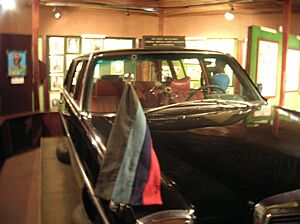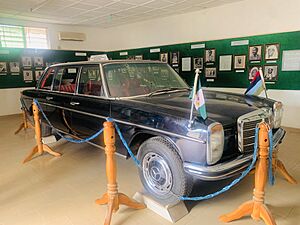Murtala Muhammed facts for kids
Quick facts for kids
General
Murtala Muhammed
|
|
|---|---|
 |
|
| 4th Head of State of Nigeria | |
| In office 29 July 1975 – 13 February 1976 |
|
| Chief of Staff | Olusegun Obasanjo |
| Preceded by | Yakubu Gowon |
| Succeeded by | Olusegun Obasanjo |
| Personal details | |
| Born | 8 November 1938 Kano, Northern Region, British Nigeria (now Kano, Kano State, Nigeria) |
| Died | 13 February 1976 (aged 37) Lagos, Nigeria |
| Cause of death | Assassination |
| Political party | (none) military |
| Spouse |
Ajoke Muhammed
(m. 1963) |
| Relations | Ireti Kingibe (sister-in-law) |
| Children | 6, including Aisha |
| Alma mater |
|
| Occupation | Military officer |
| Nickname | "Monty of the Midwest" |
| Military service | |
| Allegiance | |
| Branch/service | |
| Years of service | 1958–1976 |
| Rank | |
| Battles/wars | Congo Crisis Nigerian Civil War
|
Murtala Ramat Muhammed (born November 8, 1938 – died February 13, 1976) was a Nigerian general and leader. He played a big role in Nigeria's history. He became the Head of State of Nigeria on July 29, 1975. He led the country until he was sadly killed on February 13, 1976. His time in power was short but very important for Nigeria.
Murtala Muhammed was born in Kano, Nigeria. He joined the Nigerian Army and trained to be an officer. He quickly moved up the ranks. He became a brigadier general when he was only 33 years old. Before becoming Head of State, he was also the Federal Commissioner for Communications. He believed in a strong, united Nigeria.
Contents
Who Was Murtala Muhammed?
Early Life and Education
Murtala Ramat Muhammed was born on November 8, 1938, in Kano. His family had a history of being important judges. His father worked for the Kano Native Authority. His mother was from the Kanuri and Fulani tribes.
He went to Cikin Gida Elementary School. Then he attended Gidan Makama primary school in Kano. After that, he went to Kano Middle School. In 1949, he joined the famous Government College in Zaria. This school is now called Barewa College. He finished school there in 1957. At Barewa College, he was part of the Cadet Corps. He was also the captain of the shooting team.
Joining the Army
Murtala Muhammed joined the Nigerian Army in 1958. He had short training periods in Nigeria and Ghana. He then trained to be an officer at the Royal Military Academy Sandhurst in England. After his training, he became a second lieutenant in 1961. He was assigned to the Nigerian Army Signals. He also spent some time serving in Congo.
In 1962, he became an aide to the administrator of the Western Region. In 1963, he was in charge of the First Brigade Signal Troop in Kaduna. He went to England for more training in telecommunications. When he came back in 1964, he was promoted to major. He became the officer-commanding the 1st Signal Squadron in Lagos. By November 1965, he was the acting Chief of Signals for the Army.
His Role in Nigeria's Changes
Murtala Muhammed was against the government of Johnson Aguiyi-Ironsi. This government took power after a military takeover in January 1966. Many people in the northern part of Nigeria were unhappy. They felt the new leader was not fair. Muhammed and other officers started thinking about changes.
On July 29, 1966, soldiers in Abeokuta started a counter-coup. This was a plan to take over the government again. Muhammed was a key leader in this event. After the counter-coup, Yakubu Gowon became the new Supreme Commander. Muhammed was confirmed as a Lieutenant Colonel. He was also appointed Inspector of Signals.
During the Civil War
When the Nigerian Civil War started, Muhammed led the 2nd Infantry Division. This division helped push back the Biafran Army. They crossed the River Niger and joined up with another division. This was a very difficult task. Thousands of soldiers died during these crossings.
After the war, he continued to serve in the army. He was promoted to brigadier-general in October 1971. Between 1971 and 1974, he worked in the signals unit. He also disagreed with some of the government's policies.
In August 1974, General Yakubu Gowon made him the Federal Commissioner for Communications. This meant he was in charge of improving Nigeria's communication systems. He also kept his military duties.
Leading Nigeria
Becoming Head of State
On July 29, 1975, General Yakubu Gowon was removed from power. This happened while he was at a meeting in Uganda. Murtala Muhammed then became the new Military Head of State. He appointed Olusegun Obasanjo as his Chief of Staff. He also appointed Theophilus Danjuma as the Chief of Army Staff.
Popular Decisions
When he took power, he used phrases like "Fellow Nigerians" and "with immediate effect." These phrases became very famous. His quick decisions made him popular with many people. He was seen as a strong and decisive leader.
His government made many changes. He wanted to make the government work better. He also started to reduce the size of the armed forces. The number of troops went from 250,000 to 150,000.
Key Changes He Made
Murtala Muhammed's government took control of the country's two biggest newspapers. This meant all media in Nigeria was now under federal control. He also took federal control of the remaining state-run universities.
On February 3, 1976, his government created new states. This increased the total number of states in Nigeria to nineteen. He also made plans to build a new capital city for Nigeria. Lagos was too crowded. A special panel chose the Abuja area for the new capital. He announced that the capital would move to this new central location.
His government also tried to improve the civil service. They wanted to make it more disciplined and effective.
Economic Plans
As Head of State, Murtala Muhammed had a lot of oil and gas resources. But in 1975, Nigeria earned less money from oil. This was because global demand for oil was low. This meant the government had less money for its development plans.
His Death
On February 13, 1976, General Muhammed was going to work. His car was moving slowly in Lagos traffic. A group of soldiers attacked his car. These soldiers were part of a failed coup attempt. They shot and killed Murtala Muhammed. He was 37 years old. His aide-de-camp, Lieutenant Akintunde Akinsehinwa, was also killed.
The assassination was part of a coup attempt led by Lt. Col. Buka Suka Dimka. Dimka was later caught and punished for his actions.
His Legacy
After his death, Olusegun Obasanjo became the Head of State. Obasanjo continued Muhammed's plan to return Nigeria to civilian rule. He handed power to Shehu Shagari in 1979.
Today, Murtala Muhammed is remembered in Nigeria. His picture is on the 20 Naira banknote. The Murtala Muhammed International Airport in Lagos is also named after him.
Family Life
Murtala Muhammed was married to Ajoke Muhammed. They had six children together. Their children are Aisha, Zakari (who has passed away), Fatima, Abba (also known as Risqua), Zeliha, and Jummai. His son, Abba Muhammed, later worked as an adviser to President Olusegun Obasanjo.
Awards and Medals
Murtala Muhammed received several awards and medals for his service. These included:



